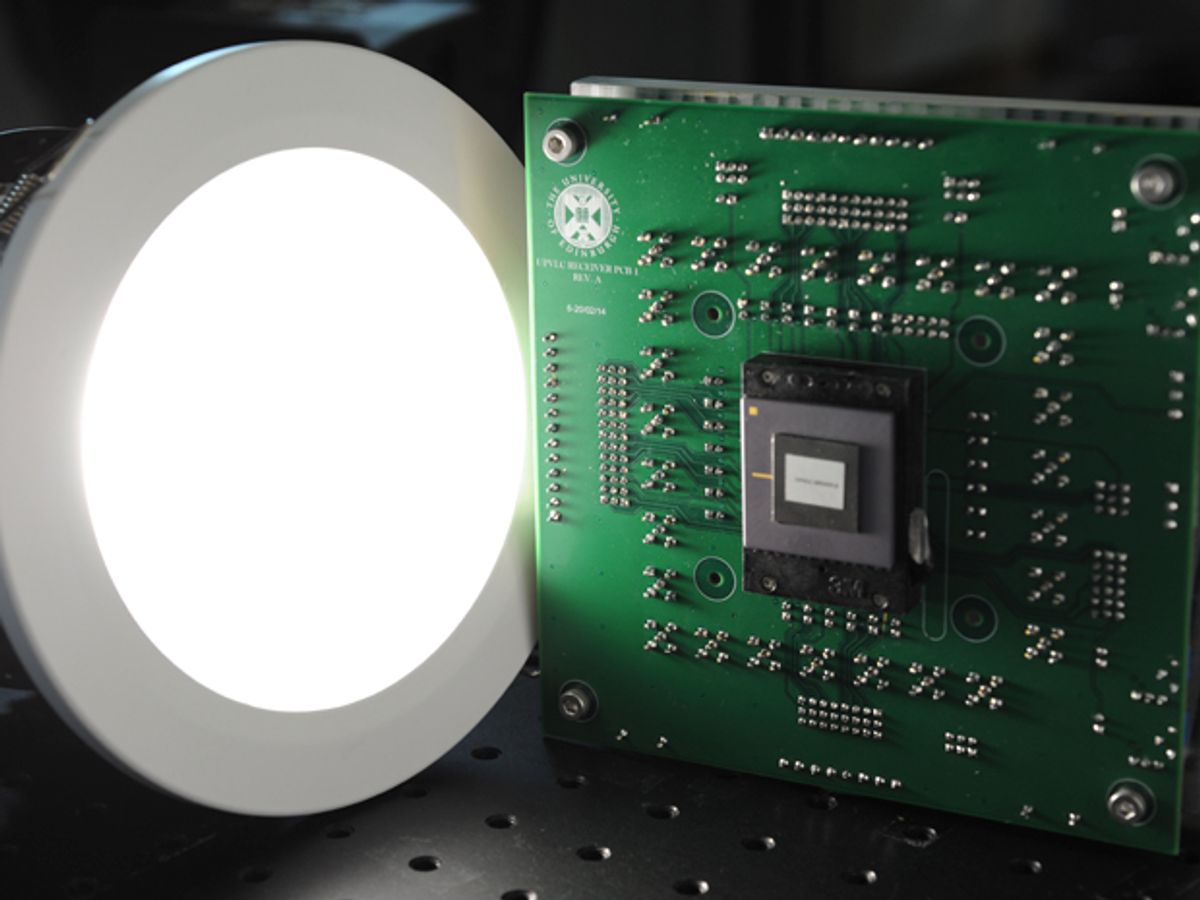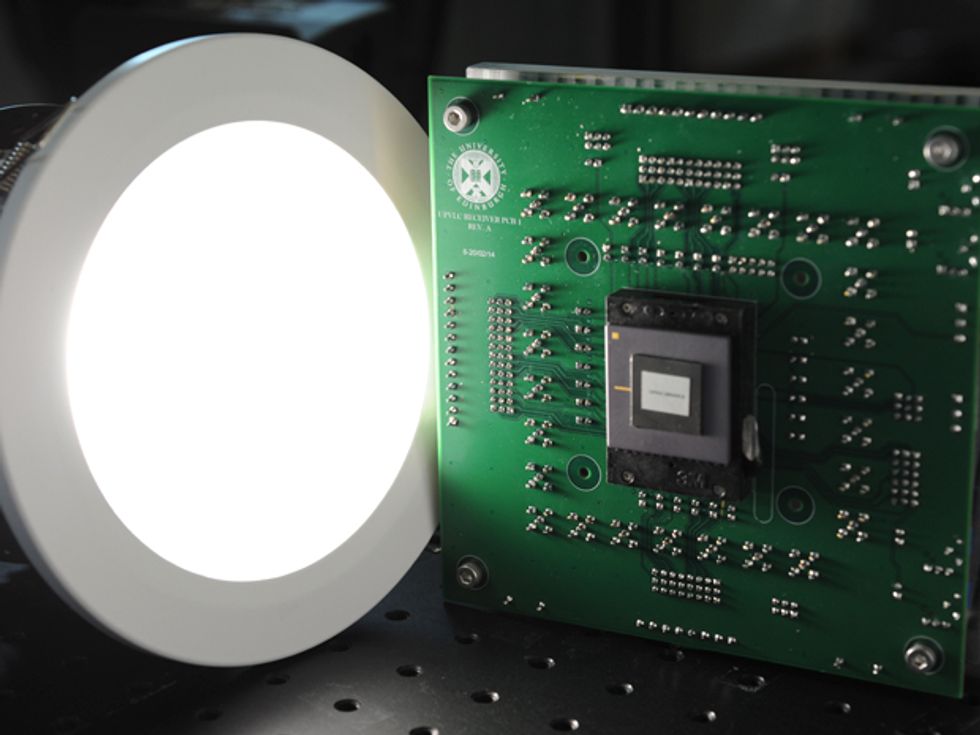As LEDs become a more common source for room lighting, they’re opening a new pathway for linking mobile devices to the Internet, with the potential for wider bandwidth and quicker response time than Wi-Fi. At least that’s what researchers such as Harald Haas, chair of mobile communications at the University of Edinburgh, are hoping.
“All the components, all the mechanisms exist already,” Haas says. “You just have to put them together and make them work.”
Haas’s group, along with researchers from the Universities of Cambridge, Oxford, St. Andrews, and Strathclyde, are halfway through a four-year, £5.8 million project funded by the Engineering and Physical Sciences Research Council, in the United Kingdom. They are pursuing ultraparallel visible light communication, which would use multiple colors of light to provide high-bandwidth linkages over distances of a few meters. Such a Li-Fi system, as it’s been dubbed, could supplement or in some instances replace traditional radio-based Wi-Fi, they say. But taking on such a broadly used radio technology is an uphill battle.
At the IEEE Photonics Conference in October, members of the consortium showed off the progress they’re making. For instance, the team has used commercially available red, green, and blue LEDs as both emitters and as photodiodes to detect light. By doing that, they created a system that could both send and receive data at aggregate rates of 110 megabits per second. When transmitting in one direction only, they reached a rate of 155 Mb/s.
But Haas says that this version is limited by existing LEDs, and by the use of LEDs as transmitters and detectors at the same time. Members of the consortium, however, have created a better LED, which provides a data rate close to 4 gigabits per second operating on just 5 milliwatts of optical output power and using high-bandwidth photodiodes at the receiver. With a simple lens to enhance the distance, they can send data 10 meters at up to 1.1 Gb/s, and soon they will increase that to 15 Gb/s, Haas says. The 802.11ad Wi-Fi standard for the 60-gigahertz radio band reaches just under 7 Gb/s, so Li-Fi would more than double that rate.
They’re also using avalanche photodiodes to make better receivers. In an avalanche photodiode, a single photon striking the receiver produces a cascade of electrons, amplifying the signal. Haas’s team at the Li-Fi R&D Centre has created the first receiver chip for Li-Fi with integrated avalanche photodiodes on CMOS. The 7.8-square-millimeter IC houses 49 photodiodes.
Separately, the Fraunhofer Institute for Photonic Microsystems, in Dresden, Germany, had announced plans to demonstrate a Li-Fi hot spot in November (after press time) at the Electronica 2014 trade show in Munich. Frank Deicke, who leads the team developing Li-Fi at Fraunhofer, says that the system would most likely use infrared light and is aimed at industrial users rather than consumers. The hot spot was set to be a point-to-point link with a data rate of up to 1 Gb/s.
“You can have more or less the same data rate as over a USB cable,” Deicke says. “That’s very challenging for most wireless technologies, like Wi-Fi and Bluetooth.” Another advantage, says Deicke, is that the latency of Wi-Fi—the time between when a signal is sent and when it’s received—is measured in milliseconds, whereas Li-Fi’s latency is on the order of microseconds. In industrial applications, where data has to flow between sensors, actuators, and a control unit, low latency and high data rates would make Li-Fi useful in places where Wi-Fi is not. “We don’t want to replace Wi-Fi,” he says. “That’s not our goal.”
But Deicke says Li-Fi could complement existing communications technologies, including Wi-Fi and gigabit Ethernet. For now, his group is not focusing on combining it with general lighting, as Haas proposes.
A group of European academic researchers and networking companies is aiming for the consumer market, though. The group is working on a project called Advanced Convergent and Easily Manageable Innovative Network Design (ACEMIND) to develop ways to manage local networks in homes and small businesses. ACEMIND includes a number of demonstrator projects to test different technologies, including Li-Fi. Dmitris Katsianis at the University of Athens, who is a participant in ACEMIND, thinks Li-Fi might be in practical use within the next five years. “Li-Fi has the advantage of being useful in electromagnetically sensitive areas such as in hospitals, aircraft cabins, and power plants,” he says.
Haas is counting on a much bigger market. He expects LEDs to evolve past just being light sources, much the same way the cellphone evolved from a communications device to a mobile computer. “In 25 years, every lightbulb in your house will have the processing power of your cellphone today,” he says. “It will in the future serve illumination as just one of many purposes.”
About the Author
Neil Savage, based in Lowell, Mass., writes about strange semiconductors, unusual optoelectronics, and other things. In the May 2014 issue he reported on weird ways to make things invisible.
A correction to this article was made on 20 November 2014.
Neil Savage is a freelance science and technology writer based in Lowell, Mass., and a frequent contributor to IEEE Spectrum. His topics of interest include photonics, physics, computing, materials science, and semiconductors. His most recent article, “Tiny Satellites Could Distribute Quantum Keys,” describes an experiment in which cryptographic keys were distributed from satellites released from the International Space Station. He serves on the steering committee of New England Science Writers.




